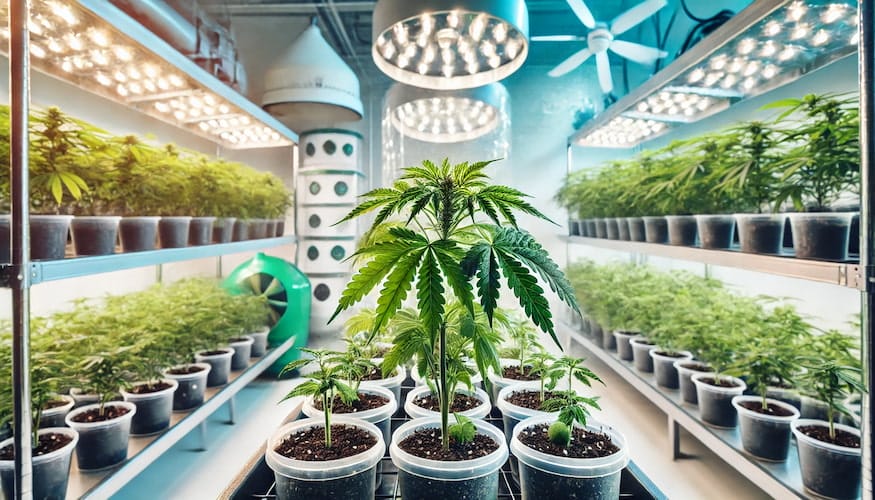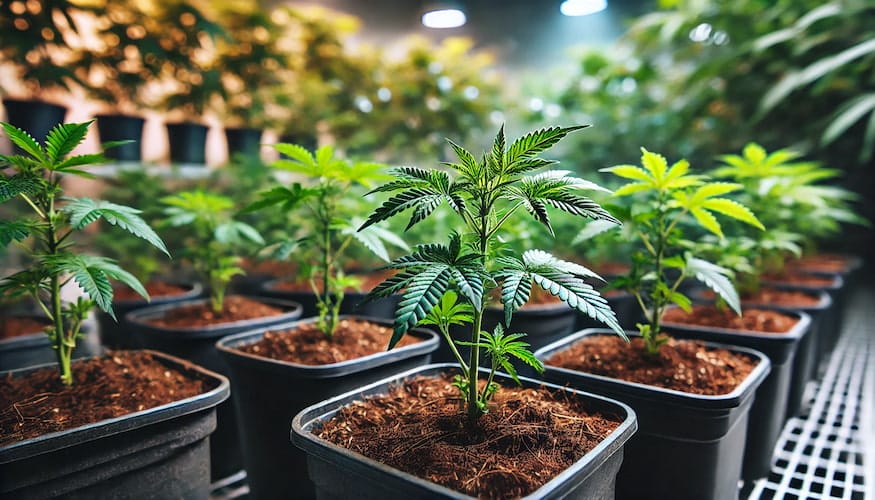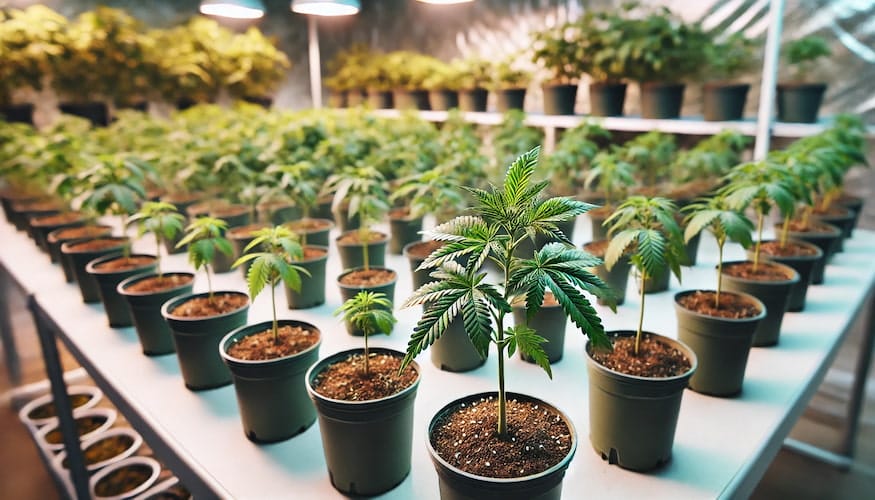Growing cannabis clones can be a rewarding endeavor. It’s a process that requires knowledge, patience, and the right resources. If you’re looking to dive into the world of cannabis cultivation, starting with clones can be a great choice. Clones offer a range of benefits over seeds, including consistency and quicker harvest times.
But where do you find high-quality cannabis clones for sale? Look no further than SeedsHereNow.com and IWantClones.com. These platforms offer a wide selection of top-notch clones, ready for your grow room.
In this guide, we’ll walk you through the process of growing cannabis clones. We’ll cover everything from selecting the right clone to the best practices for ensuring their healthy growth. Whether you’re a novice grower or an experienced cultivator, this guide is for you. Let’s dive in and explore the fascinating world of cannabis clones.
Understanding Cannabis Clones
Cannabis clones are cuttings taken from a mother plant. These cuttings are then rooted and grown into new plants.
The beauty of clones is that they are genetic replicas of the mother plant, which means they’ll have the same characteristics as the parent, including potency, flavor, and growth patterns. Cloning is a popular method among growers for several reasons, one of which is the ability to replicate high-performing plants. If you have a plant that yields well and has great features, you can create an entire garden of that same plant.
Another benefit is the time saved. Clones skip the germination stage that seeds have to go through, meaning you can harvest your cannabis plants sooner.
Understanding what cannabis clones are and their benefits is the first step in successful cloning. With this knowledge, you’re well on your way to cultivating your own cannabis clones.
Start With High-Quality Clones
When it comes to growing cannabis clones, starting with high-quality genetics is crucial. This is where SeedsHereNow.com and IWantClones.com come into play.
These platforms offer a wide range of cannabis clones for sale. They source their clones from reputable breeders, ensuring you get the best genetics. The quality of your clones directly impacts your final product. High-quality clones are more likely to grow into healthy, robust plants. They’re less prone to disease and pests, and they also produce higher yields and better-quality buds.
SeedsHereNow.com and IWantClones.com also provide excellent customer service, offering guidance and support throughout the growing process. This can be invaluable, especially for novice growers. Starting with high-quality clones from trusted sources like SeedsHereNow.com and IWantClones.com sets you up for success. It’s an investment in your cannabis cultivation journey.
The Legal Landscape: Purchasing Cannabis Clones
Before diving into the world of cannabis clones, it’s important to understand the legal landscape. Laws around cannabis cultivation vary widely from state to state.
In some areas, growing cannabis at home is perfectly legal, while in others, it’s strictly regulated or even prohibited. It’s crucial to research your local laws before purchasing cannabis clones.
Remember, compliance with state laws is not just about avoiding legal trouble; it’s also about being a responsible member of the cannabis community. Always ensure your cultivation practices are legal and ethical.

Selecting the Best Cannabis Clones for Your Grow
Choosing the right clones for your grow is a critical step. Not all clones are created equal, and the health and genetics of the clone can greatly impact your final product.
Healthy clones should be vibrant green and have sturdy stems. Avoid clones with yellowing leaves or signs of pests and diseases. When it comes to genetics, consider your personal preferences and growing conditions. Some strains are better suited for indoor growing, while others thrive outdoors.
Factors To Consider When Selecting Cannabis Clones
- Strain type: Indica, Sativa, or Hybrid
- Desired effects: Relaxation, Energy, or Creativity
- Growing conditions: Indoor, Outdoor, or Greenhouse
- Plant size and yield potential
- Resistance to pests and disease
Remember, starting with high-quality clones can set you up for a successful grow. Choose wisely!
The Cloning Process: A Step-by-Step Guide
Cloning cannabis plants requires precision and care. It begins with selecting a healthy mother plant that is mature, robust, and free of diseases and pests.
Steps in the Cloning Process
- Taking Cuttings: Use a clean, sharp blade to cut a branch with several nodes at a 45-degree angle to increase the surface area for rooting.
- Preventing Air Bubbles: Immediately place the cutting in water to prevent air bubbles from forming in the stem, which can hinder root development.
- Preparing Rooting Medium: Use rockwool cubes, peat pellets, or a hydroponic system. Dip the cut end of your clone into rooting hormone before placing it in the medium.
- Maintaining Humidity: Place your clones in a humidity dome or a propagator to maintain high humidity levels (around 72 to 75 degrees Fahrenheit).
- Providing Light: Clones don’t need intense light, so use a fluorescent light or low-wattage LED kept on for 18 to 24 hours a day.
- Transplanting: After the clone has developed a robust root system, it’s ready to be transplanted into its final growing medium. Handle clones carefully during this stage.
With careful attention and the right conditions, your clones will thrive.
Creating the Ideal Environment for Cannabis Clones
Creating the right environment for your cannabis clones is crucial for their survival and growth.
Key Environmental Factors
- Temperature: Keep clones at 72 to 77 degrees Fahrenheit.
- Humidity: High humidity levels (70 to 80 percent) are ideal for clones.
- Lighting: Clones don’t need intense light; use low-wattage LED or fluorescent lights.
- Air Circulation: A gentle breeze strengthens stems. Just avoid strong winds.
By controlling these factors, you can create the ideal conditions for your clones to thrive.
Nutrients and Feeding: What Your Cannabis Clones Need To Thrive
Just like any other plant, cannabis clones need nutrients to grow. However, they require a different feeding schedule than mature plants.
Nutrient Considerations
- Initially, clones don’t need much feeding as they can survive on water and nutrients stored in their leaves.
- As roots develop, use a balanced nutrient solution low in nitrogen and high in phosphorus to encourage root growth.
- Start with a weak nutrient solution and gradually increase the strength to avoid nutrient burn.
Understanding the specific needs of the strain you’re growing will help ensure your clones get the right nutrients and thrive.
Common Pitfalls and How To Avoid Them
Growing cannabis clones can be tricky. Common mistakes include:
- Overwatering: Clones need a moist environment, but too much water can lead to root rot.
- Intense light exposure: Gradually increase light intensity as the clone matures.
- Temperature and humidity control: Aim for a temperature around 72 to 77 degrees Fahrenheit and humidity around 70 to 80 percent.
- Handling clones: They are delicate and should be handled only when necessary.

Transplanting Clones: Ensuring a Smooth Transition
Transplanting is a critical step in the cloning process.
Tips for Transplanting
- Prepare your growing medium in advance. It should be moist but not waterlogged.
- Gently place the clone into the prepared hole, lightly covering the roots with soil.
- Monitor closely for signs of stress like wilting or yellowing leaves.
Pest Management and Disease Prevention in Clones
Preventing pests and diseases is essential to maintaining healthy clones.
Prevention Tips
- Maintain a clean growing environment and regularly inspect your clones for pests or diseases.
- If issues arise, use organic pest control methods or disease treatments as needed.
Conclusion: The Future of Your Grow Operation
Learning how to grow cannabis clones is an invaluable skill for any serious cultivator. Not only does cloning allow for faster production cycles, but it also ensures the preservation of desirable traits, leading to more consistent and high-quality harvests. By following the steps in this guide—choosing the right mother plant, taking clean cuttings, maintaining the correct environment, and providing proper care—you can become proficient in cloning and elevate your cannabis cultivation game.
As you gain experience, you’ll develop your own techniques and preferences for cloning. Some growers may experiment with different rooting mediums, others may perfect their humidity and light control, while some may focus on producing mother plants that yield clones with exceptional vigor. The beauty of cannabis cultivation lies in the constant learning and adapting that comes with the growing process.
So whether you’re aiming to preserve a legendary strain, speed up your grow cycles, or produce a perpetual harvest, cloning is a technique that can transform your approach to growing cannabis. Embrace the process, be patient, and enjoy the rewarding results that come from mastering the art of cannabis cloning. Happy growing!
Ready to get your grow on? Shop our collection of

;)
;)
;)

;)
;)
;)
RESPONSES (0)
No responses yet. Be the first to respond!